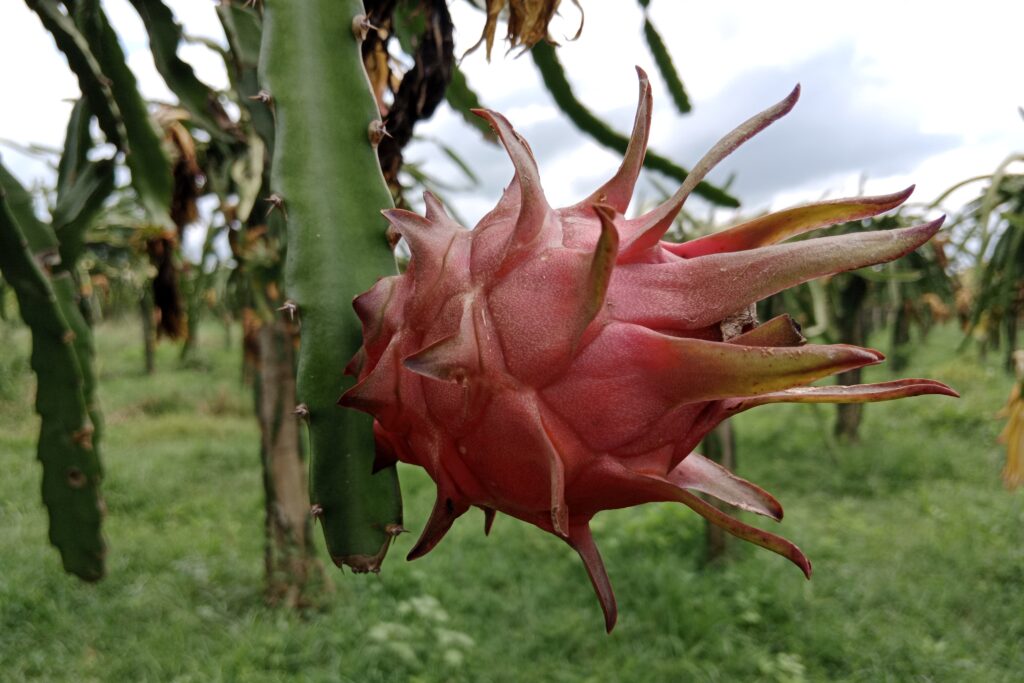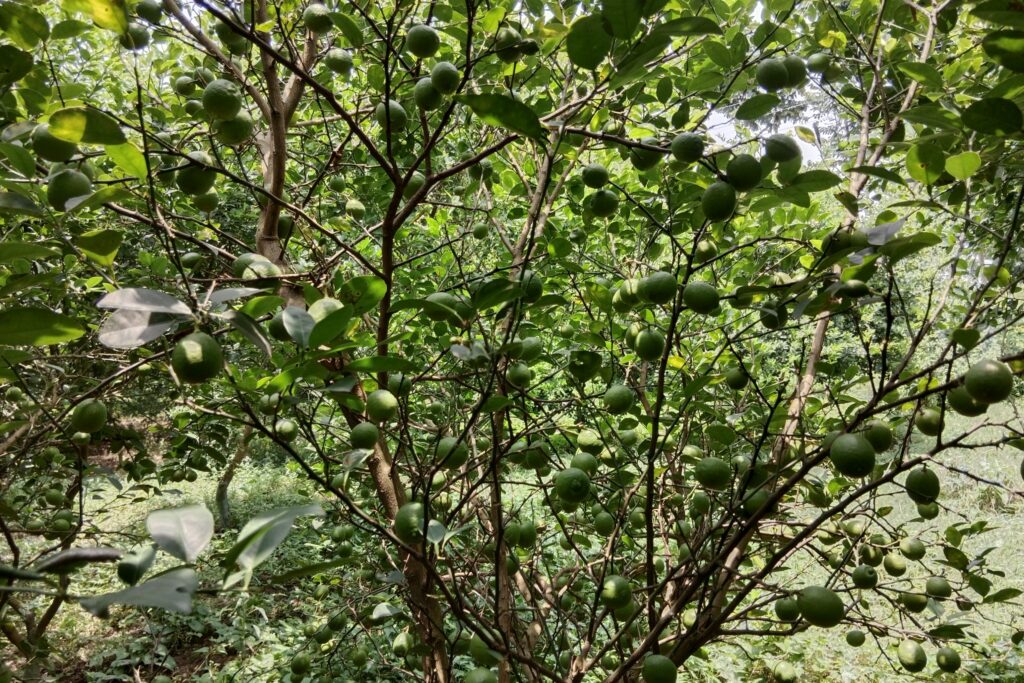Lemongrass Farming
Lemongrass (Cymbopogon citratus) is a versatile perennial grass widely cultivated for its aromatic leaves and essential oil, which are valued in culinary, medicinal, and industrial applications. Known for its distinctive citrus fragrance, lemongrass thrives in tropical and subtropical climates, requiring well-drained soils and moderate care for successful growth.
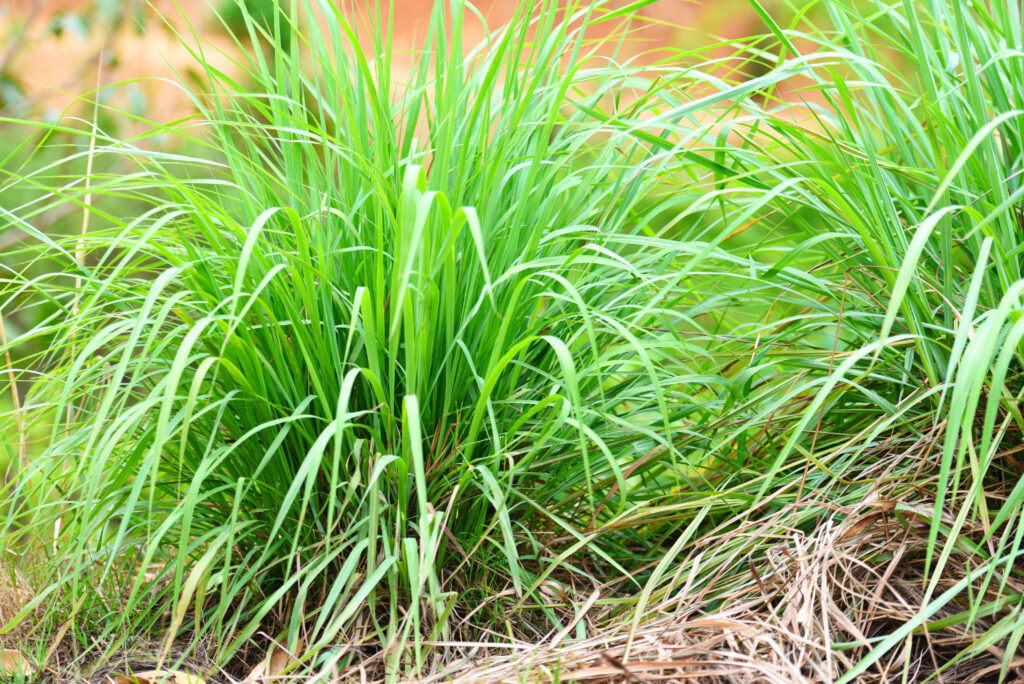
With increasing demand in the food, pharmaceutical, and cosmetic industries, lemongrass cultivation has gained popularity as both a sustainable and profitable agricultural enterprise.
Lemongrass farming profit per acre demonstrates the high potential of this crop as a lucrative venture, with a total net profit of NRs. 1,315,000 over five years against a total cost of NRs. 325,000. One of its biggest advantages is the quick payback, as the initial investment of NRs. 85,000 is recovered within the very first year, yielding a profit of NRs. 75,000.
The second and third-years mark peak production and profitability, generating returns of NRs. 540,000 and NRs. 380,000 respectively, which aligns with the growth cycle of perennial grasses. However, yields gradually decline after the third year, making replanting every four to five years necessary to sustain high productivity.
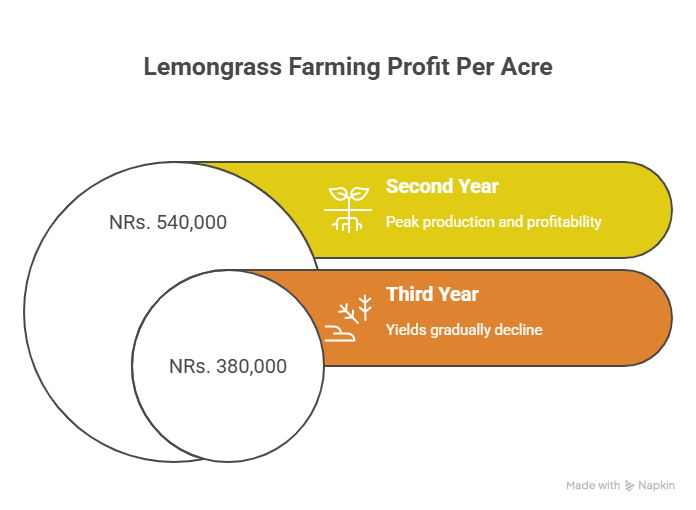
Overall, the enterprise offers an outstanding return on investment, with profits exceeding four times the total investment, equating to an impressive 405% ROI across the five-year period.
Land Preparation
For successful lemon grass cultivation, proper land preparation is essential. The field should first be plowed deeply 2–3 times to a depth of 15–20 cm to break soil clods, create a fine tilth, and promote better root development while preventing waterlogging.
After plowing, harrowing and leveling are carried out to further crush clods and ensure an even surface, which helps in uniform irrigation and avoids water stagnation. Finally, basins or rows are prepared depending on the planting method, and all weeds or crop residues are removed to reduce the risk of pest and disease infestation.
Soil Type
Lemongrass grows best in well-drained, fertile loamy soil and can tolerate a wide pH range from 5.0 to 8.0, though the optimal range is between 6.0 and 7.5. However, it is highly sensitive to waterlogged conditions and cannot thrive in saline or highly alkaline soils, making good drainage essential to prevent root and tiller rot.
Climatic Requirements
Lemongrass thrives in warm, humid tropical and subtropical climates, with an optimum temperature range of 20°C to 30°C and high sensitivity to frost. It requires 150–250 cm of well-distributed annual rainfall, tolerating short dry spells but depending on consistent moisture for high herbage yield. Full sunlight is essential for vigorous growth and maximum oil content, as shaded conditions result in poor development and reduced yield.
Major Cultivars
Lemongrass cultivars are selected primarily for their high oil content, citral concentration, and suitability to the specific local growing conditions.
| Variety Name | Origin/Type | Key Characteristics |
| OD-19 | Indian (Hybrid) | High-yielding; high oil content (~0.7%); rich citral content (~85%). |
| CKP-25 (Krishna) | Indian (Hybrid) | Bold stem; high herbage and oil yield; resistant to rust disease. |
| RRL-39 | Indian (Hybrid) | Known for early maturity and good regeneration capacity. |
| Jamaican | International Strain | Known for a strong aroma. |
| Guatemalan | International Strain | Known for a strong aroma. |
| Local Landraces | Indigenous | Well-adapted to specific local micro-climates; often propagated by farmers for their successful local performance. |
Propagation
Lemongrass is primarily propagated vegetatively to preserve genetic purity and oil quality, with propagation carried out through slips obtained from healthy, disease-free mother plants that are over six months old. The clumps are uprooted and carefully divided with a sharp cut at the base, ensuring each slip contains a small shoot (pseudostem) along with a portion of the root system (rhizome) and at least one active growing bud.
Seed Rate per Acre
In lemongrass cultivation, propagation is done through slips rather than seeds, and about 20,000 slips are required per acre when planted at the recommended spacing.
Nursery Management
While not always mandatory, nursery management is highly beneficial for large-scale lemongrass cultivation or when mother stock is limited, as it helps raise healthy and uniform planting material. Raised beds are prepared in a protected area where slips are planted closely at 10 cm × 10 cm spacing, provided with regular irrigation and light shade until they are well established. After 6–8 weeks, once the slips develop a strong root system and new tillers, they are ready for transplanting into the main field.
Planting
a). Planting Season
The most suitable season for planting lemongrass is at the onset of the monsoon (June–July), as the abundant soil moisture during this period ensures proper establishment, though in irrigated conditions it can also be planted in spring (February–March) or early autumn.
b). Spacing
A spacing of 45 cm x 45 cm is common. This allows enough space for tiller development and enables inter-cultural operations.
c). Pit Preparation
Small pits of 15 cm x 15 cm x 15 cm are dug at the marked spots.
d). Planting Method
Apply a handful of well-decomposed farmyard manure (FYM) mixed with soil in each pit. Place one healthy slip in the center of the pit and fill it with soil, pressing firmly around the base.
e). Number of Plants per Acre
At a spacing of 45 cm × 45 cm, an acre accommodates approximately 19,985 slips, and one slip is planted in each pit.
Intercropping
Intercropping in lemongrass is feasible only during the first 3–4 months after planting, before the canopy closes, and can include short-duration, low-growing crops such as pulses (green gram, black gram), vegetables (okra, radish), or spices (coriander), allowing for optimal land use and additional income during the establishment year.
Irrigation
Irrigation is critical for lemongrass, beginning with a light irrigation immediately after transplanting. During the establishment phase for the first month, frequent irrigation every 2-3 days is necessary to ensure good survival. Once the crop is established, the schedule shifts to every 7-10 days in the summer and every 15-20 days in the winter. While the crop can withstand mild drought, yields will suffer, so it is important to avoid both prolonged dry spells and the opposite extremes of overwatering and waterlogging.
Fertilizer and Manure Application (per acre)
| Fertilizer Type | Recommended Dose | Application Method & Timing |
| Well-rotted FYM/Compost | 10 – 15 tonnes | Applied as a basal dose during final land preparation. |
| Nitrogen (N) | 50 – 60 kg (110-130 kg Urea) | Applied in 2-3 split doses: first at planting, with subsequent doses after each harvest. |
| Phosphorus (P₂O₅) | 25 – 30 kg (155-185 kg Single Super Phosphate) | Full dose applied as a basal dose during preparation. |
| Potassium (K₂O) | 25 – 30 kg (40-50 kg Muriate of Potash) | Full dose applied as a basal dose |
Weed Control
Weed control is crucial during the first three months of lemongrass cultivation, as young plants are slow-growing and easily outcompeted by weeds. Effective management includes 2–3 manual hand weedings or hoeings in the first year, mulching with organic materials such as straw or grass clippings—or plastic mulch—to suppress weeds and conserve soil moisture, and, if necessary, the use of pre-emergence herbicides like Atrazine, although manual weeding is generally preferred for this aromatic crop.
Inter Culture Operation
Interculture operations in lemongrass primarily involve pruning or desuckering, which includes removing old, dead, and diseased leaves and tillers from the base of the clumps during weeding. This practice improves air circulation, reduces pest harborage, and promotes the growth of new, healthy tillers.
Flowering and Fruit Management
Flowering and Fruit Management is a critical practice, as lemongrass is a short-day plant that typically flowers during the winter when day lengths are shorter. This flowering is highly undesirable for oil production because it diverts the plant’s energy away from leaf growth, significantly reducing both herbage and essential oil yield.
To proactively prevent this, a management technique called ratooning, or harvesting, is scheduled just before the flowering season begins. If flowering stalks manage to appear, they should be cut off immediately to preserve the crop’s yield potential.
Pest and Disease Management
Common Pests
a). Nematodes
Nematodes are microscopic pests that cause root knots in lemongrass, leading to stunted growth and reduced yield. Effective management includes practicing crop rotation with marigold, which acts as a natural nematode deterrent, using healthy and disease-free planting material, and incorporating organic amendments such as compost or well-decomposed farmyard manure to improve soil health and suppress nematode populations.
b). Grasshoppers & Leaf Feeders
Grasshoppers and other leaf-feeding insects damage lemongrass by chewing on leaves, leading to defoliation and reduced growth and oil yield. When pest populations exceed the economic threshold, targeted chemical control may be necessary.
Effective options include Chlorantraniliprole 18.5% SC at 30–40 ml per 100 litres of water, Lambda-cyhalothrin 5% EC at 1.5–2 ml per litre, and Malathion 50% EC at 2 ml per litre.
To minimize environmental impact and protect beneficial insects, sprays should be applied early in the morning or late in the evening, and insecticides with different modes of action should be rotated to prevent resistance. Always follow label instructions carefully for dosage, safety intervals, and pre-harvest intervals (PHI).
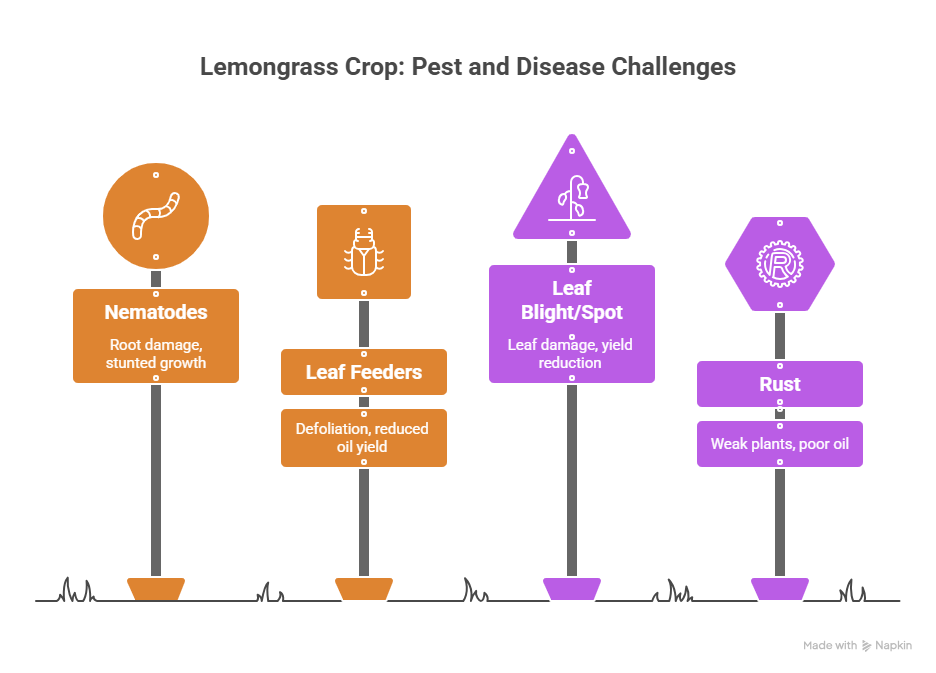
Common Diseases
Leaf Blight/Leaf Spot
Leaf blight or leaf spot manifests as small to large brown lesions on lemongrass leaves, which can coalesce and cause significant leaf damage, reducing growth and oil yield. Management involves avoiding overhead irrigation to minimize leaf wetness, maintaining proper plant spacing for adequate air circulation, and applying fungicides.
Bordeaux mixture (copper sulfate 1% + lime 1%) can be sprayed at 500–600 litres per hectare, or other copper-based fungicides such as Copper Oxychloride 0.25% (25 g per 10 litres of water) can be used. Fungicide applications should begin at the first appearance of symptoms and be repeated every 10–15 days or after heavy rains.
Rust
Rust disease appears as reddish-brown pustules on the leaf surface, weakening plants and reducing oil quality. Management includes growing resistant varieties like CKP-25, removing and destroying infected leaves to reduce inoculum, and applying fungicides.
Effective chemical control includes Mancozeb 75% WP at 20–25 g per 10 litres of water or Copper Oxychloride 0.25% as described above. Spraying should be done at the early stages of disease development and repeated every 10–15 days, particularly during humid conditions that favor rust development.
Always follow label instructions for dosage, safety precautions, and pre-harvest intervals to ensure effective and safe disease control.
Harvesting
The first harvest of lemongrass is typically ready 90–100 days after planting, with subsequent harvests possible at intervals of 50–60 days depending on growth and season. Harvesting is carried out by cutting the above-ground biomass 10–15 cm above the ground using a sickle or knife, as cutting too low can damage the rhizome. For best results, harvesting should be done on a sunny day, preferably late in the morning after the dew has dried.
Yield
Lemongrass yield depends on cultivar, soil fertility, irrigation, and crop age. In the first year, fresh herbage yield ranges from 25–30 tonnes per acre from 2–3 harvests, while peak yields of 35–45 tonnes per acre are achieved in the second and third years, after which productivity declines and replanting is recommended.
Essential oil content varies between 0.3% and 0.7% of fresh herb weight, yielding approximately 70–150 kg of oil per acre per year. The oil is extracted from fresh or partially dried herb through steam distillation.
Cost of Investment per Acre for Lemongrass Farming
| S.N. | Categories | Cost (NRs.) |
| 1 | Land Preparation | 15,000 |
| 2 | Planting Material (“Slips”) | 15,000 |
| 3 | Planting | 3,000 |
| 4 | Fertilizers & Manure | 9,000 |
| 5 | Irrigation | 20,000 |
| 6 | Weed Control (Pre & Post-emergence) | 5,000 |
| 7 | Pest & Disease Control | 8,000 |
| 8 | Harvesting | 5,000 |
| 9 | Miscellaneous Costs | 5,000 |
| Total Initial Cost (1st Year) | 85,000 |
Annual Maintenance Cost Per Acre
The annual maintenance cost of lemongrass farming from the second year onwards is estimated at NRs. 60,000 per acre, which includes expenses for irrigation, fertilizer and manure application, weed management, pest and disease control, harvesting, and other routine operational requirements necessary to sustain crop health and productivity.
This recurring cost ensures the plants remain vigorous and capable of delivering optimal yields throughout their productive cycle, thereby supporting consistent profitability over the years.
Income per acre from Lemongrass Farming
| Year | Estimated Yield (kg) | Market Price (NRs./kg) | Total Income (NRs.) |
| 1st Year | 8,000 | 20 | 160,000 |
| 2nd Year | 30,000 | 20 | 600,000 |
| 3rd Year | 22,000 | 20 | 440,000 |
| 4th Year | 16,000 | 20 | 320,000 |
| 5th Year | 6,000 | 20 | 120,000 |
| Total Gross Income (5 Years) | 1,640,000 |
Analysis of Lemongrass Farming Profit Per Acre
| Year | Gross Income (NRs.) | Total Cost (NRs.) | Net Profit (NRs.) |
| 1 | 160,000 | 85,000 | 75,000 |
| 2 | 600,000 | 60,000 | 540,000 |
| 3 | 440,000 | 60,000 | 380,000 |
| 4 | 320,000 | 60,000 | 260,000 |
| 5 | 120,000 | 60,000 | 60,000 |
| Total | 1,640,000 | 325,000 | 1,315,000 |
Lemongrass farming appears to be a highly profitable venture, demonstrating high profitability with a total net profit of NRs. 1,315,000 per acre over five years against a total cost of NRs. 325,000. A key advantage is its quick payback, as the initial investment of NRs. 85,000 is recovered within the first year alone, generating a profit of NRs. 75,000 right away.
The operation sees peak production in the second and third years, which are the most profitable with returns of NRs. 540,000 and NRs. 380,000 respectively, which is typical for perennial grasses; however, a noticeable yield decrease begins after the third year, which is the standard reason for replanting every four to five years to maintain high productivity.
Ultimately, the venture offers an impressive return on investment (ROI), with the total profit representing over four times the total investment, equating to an approximately 405% ROI over the five-year period.
Sources
Food and Agriculture Organization (FAO)
University of California Agriculture & Natural Resources (UC ANR)
European Plant Protection Organization (EPPO)
Punjab Agricultural University (PAU)
Tamil Nadu Agriculture University (TNAU) – Agritech portal
Indian Council of Agricultural Research (ICAR)
Nepal Agricultural Research Council (NARC)
U.S. Department of Agriculture (USDA).
Ministry of Agriculture and Livestock Development (Nepal)
Disclaimer: This crop farming profits assume optimal conditions. Actual results may vary depending on climate, market prices, and farm management practices.

